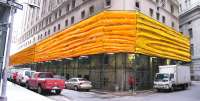Using the technique of banner advertising ubiquitous throughout the city, a scaffolding bridgeway in lower Manhattan would be wallpapered with an image of architectural material. Reclaiming architectural surfaces from the pervasion of advertising, "billbo
billboard Construction scaffolding is prevalent in renovation citywide. These scaffolds may serve to protect the public from construction above, but they effectively cut off the streetscape from the local architecture, creating dark, neutered tunnels. The scaffolding is more often than not enveloped with advertising banners without concern for the experience of the streetscape, and this encroachment is markedly resonant in the immediate vicinity of Wall Street, where all aspects of real estate are put to use promoting private profit at the expense of public space. For "billboard" a scaffolding bridgeway in lower Manhattan was to be wallpapered with an image of plywood, echoing the construction substrate beneath. As an image of plywood planks, "billboard" echoes the panels used to construct the bridgeways. By reinstating a visual of construction material, "billboard" seeks the more neutral and traditional patterning found on building facades, and relieves the streetscape from serving in the interest of private profit. The image also reflects back to the early forms of billboard advertising, such as the Burma Shave series, built on large wooden panels running along road sides. Part of a series of urban postering, "billboard" is an act of drawing directly onto the real world. While highlighting commercial practices attached to urban construction, and reclaiming architectural surfaces from the pervasion of advertising, "billboard" aims to reinvest the streetscape with a part of what’s been lost (or stolen), reengaging the public with the history and culture of the site. "billboard" was developed in conjunction with the Lower Manhattan Cultural Council for the River to River Festival in 2005. The project was never produced.
Using the technique of banner advertising ubiquitous throughout the city, a scaffolding bridgeway in lower Manhattan would be wallpapered with an image of architectural material. Reclaiming architectural surfaces from the pervasion of advertising, "billbo
billboard Construction scaffolding is prevalent in renovation citywide. These scaffolds may serve to protect the public from construction above, but they effectively cut off the streetscape from the local architecture, creating dark, neutered tunnels. The scaffolding is more often than not enveloped with advertising banners without concern for the experience of the streetscape, and this encroachment is markedly resonant in the immediate vicinity of Wall Street, where all aspects of real estate are put to use promoting private profit at the expense of public space. For "billboard" a scaffolding bridgeway in lower Manhattan was to be wallpapered with an image of plywood, echoing the construction substrate beneath. As an image of plywood planks, "billboard" echoes the panels used to construct the bridgeways. By reinstating a visual of construction material, "billboard" seeks the more neutral and traditional patterning found on building facades, and relieves the streetscape from serving in the interest of private profit. The image also reflects back to the early forms of billboard advertising, such as the Burma Shave series, built on large wooden panels running along road sides. Part of a series of urban postering, "billboard" is an act of drawing directly onto the real world. While highlighting commercial practices attached to urban construction, and reclaiming architectural surfaces from the pervasion of advertising, "billboard" aims to reinvest the streetscape with a part of what’s been lost (or stolen), reengaging the public with the history and culture of the site. "billboard" was developed in conjunction with the Lower Manhattan Cultural Council for the River to River Festival in 2005. The project was never produced.
